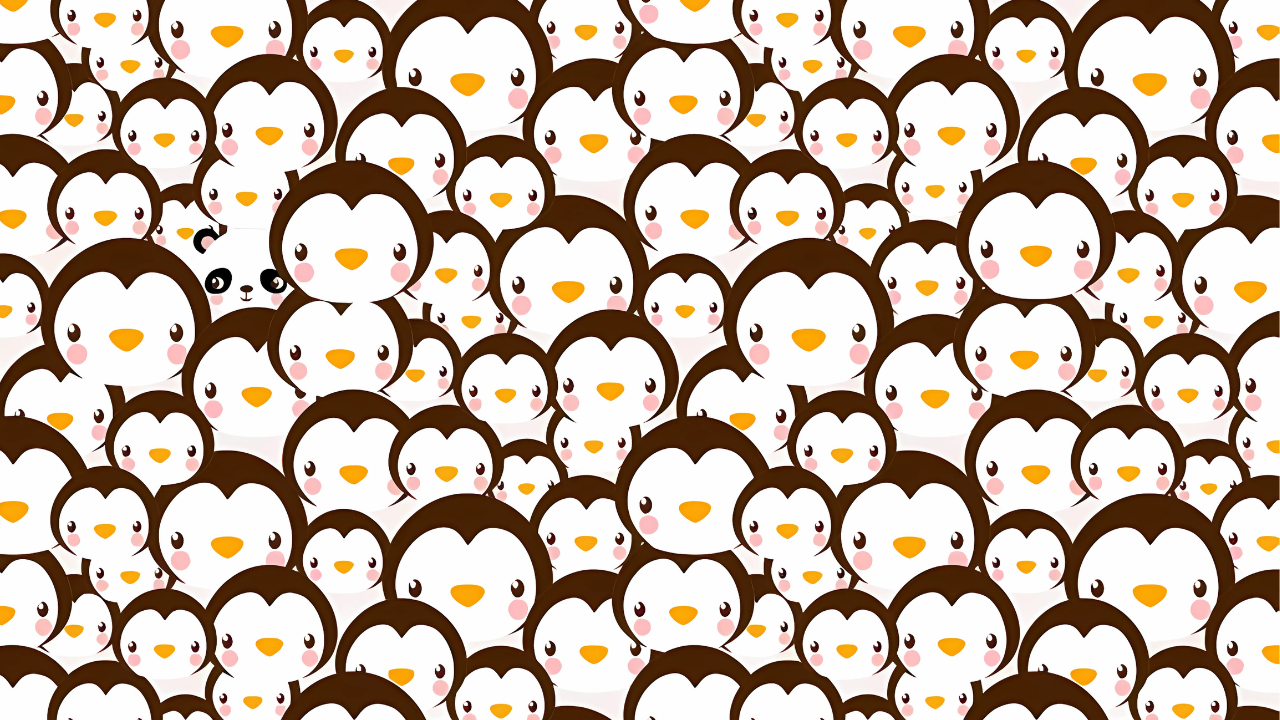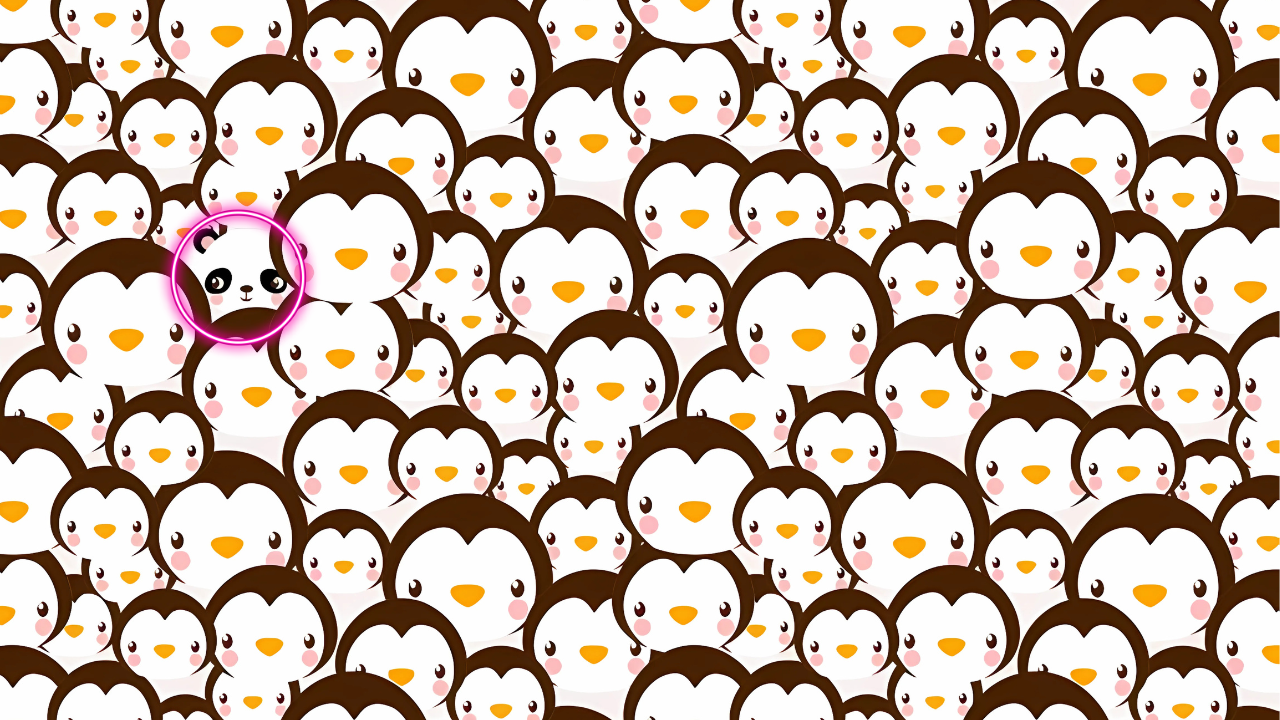The internet has been captivated by a deceptively simple yet mind-bending optical illusion that challenges viewers to spot a panda cleverly hidden among a group of penguins. This viral puzzle, featured prominently on various platforms has become a sensation among puzzle enthusiasts and casual browsers alike.
What Makes This Optical Illusion So Captivating?
The challenge requires participants to identify a camouflaged panda within a specific time frame, typically ranging from seven to thirty seconds. What appears to be a straightforward task quickly becomes a test of visual acuity and attention to detail. The panda masterfully blends with its penguin surroundings, creating a puzzle that has stumped countless viewers worldwide.
Also Read:- Only 2% Can Find USA in This Optical Illusion in Under 6 Seconds—Are You One
The Science Behind Optical Illusions
Optical illusions, also known as visual illusions, are fascinating phenomena caused by the visual system within our perception process. They create images that differ significantly from reality, challenging our brain’s ability to process visual information accurately. These brain teasers force us to look beyond our initial impressions and examine details more carefully.
Find the Panda Hidden Among Penguins in 8 Seconds

Why Penguins and Pandas Create Perfect Camouflage
The genius of this particular illusion lies in the similar color schemes between pandas and penguins. Both animals feature distinctive black and white coloring that allows the panda to seamlessly integrate into the penguin colony. This natural camouflage effect makes the hidden panda incredibly difficult to detect at first glance.
The Viral Phenomenon: How the Challenge Spread
When it comes to optical illusions, the internet seems to have an insatiable hunger for them. New optical illusions appear daily to captivate audiences from children to adults, boosting their eagerness to participate. This particular challenge gained traction across social media platforms, with millions attempting to locate the elusive panda.
Social Media Impact and Engagement
The panda-penguin illusion has generated tremendous engagement across various platforms. Users share their attempts, celebrate successes, and challenge friends to participate. This viral nature demonstrates the universal appeal of visual puzzles and the human desire to test our perceptual abilities.
Solving the Puzzle: Strategies and Techniques
The best approach to finding the panda in this image involves carefully examining the picture to identify anything that resembles a panda shape. Success requires patience, methodical scanning, and sometimes a shift in perspective.
Panda Hidden Among Penguins

Expert Tips for Success
Focus on the Right Side: The panda is typically hidden on the right side of the image, positioned beside a penguin. This knowledge can significantly reduce search time and improve success rates.
Look for Shape Differences: While penguins and pandas share similar coloring, their body shapes differ substantially. Pandas have rounder faces and different proportions compared to the sleek penguin silhouettes.
Take Your Time: Although challenges often impose time limits, methodical examination proves more effective than rushed scanning. Allow your eyes to adjust and process the visual information gradually.
Why Some People Succeed While Others Struggle
Only about ten percent of people can spot the cute panda among the penguins in less than twenty seconds. This statistic highlights the challenge’s difficulty and suggests that successful completion requires exceptional visual processing skills or specific observational techniques.
Factors That Influence Success
Individual differences in visual perception, attention to detail, and pattern recognition abilities all contribute to varying success rates. Some people naturally excel at identifying hidden objects, while others may need more time or different strategies.
The Educational Value of Visual Puzzles
Practicing optical illusions regularly offers substantial advantages, including enhanced focus and improved detail observation abilities. Additionally, these exercises contribute to developing a more knowledgeable intellect. Educational institutions and brain training programs increasingly incorporate such puzzles into their curricula.
Also Read: –Spot the Hidden Kangaroo in 10 Seconds – This Optical Illusion Is Going Viral!
Cognitive Benefits and Brain Training
Enhanced Attention Skills: Regular engagement with optical illusions sharpens focus and concentration abilities, skills that transfer to academic and professional settings.
Improved Pattern Recognition: These puzzles develop the brain’s ability to identify subtle differences and patterns, valuable skills in numerous fields including medicine, engineering, and computer science.
Stress Relief and Mental Stimulation: Visual puzzles provide healthy mental exercise while offering entertainment and stress relief from daily routines.
Applications in Education and Therapy
Educational professionals utilize optical illusions to teach concepts about perception, critical thinking, and problem-solving. Therapeutic applications include cognitive rehabilitation and attention training for various conditions.
Beyond Entertainment: The Deeper Meaning
While primarily viewed as entertainment, this optical illusion reflects broader themes about observation, patience, and the importance of looking beyond surface appearances. The challenge reminds us that valuable discoveries often require persistent effort and different perspectives.
Life Lessons from Optical Illusions
The panda-penguin puzzle teaches us that initial impressions can be misleading and that worthwhile achievements often demand patience and persistence. These lessons extend far beyond puzzle-solving into personal and professional development.
FAQs
Q: How long should I spend looking for the panda? Most challenges allow seven to thirty seconds, but take as much time as needed to enjoy the experience.
Q: What if I can’t find the panda at all? Don’t worry! Focus on the right side of the image and look for subtle shape differences between the animals.
Q: Are there other similar optical illusions? Yes! Many variations exist featuring different animals and objects hidden in plain sight.
Also Read: –Optical Illusion: Only People With Sharp Eyes Can Find the Yellow Car in This Traffic Puzzle
